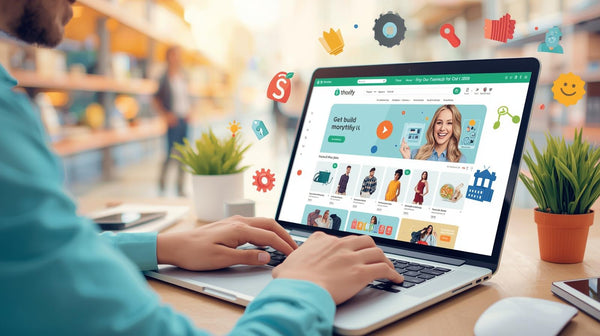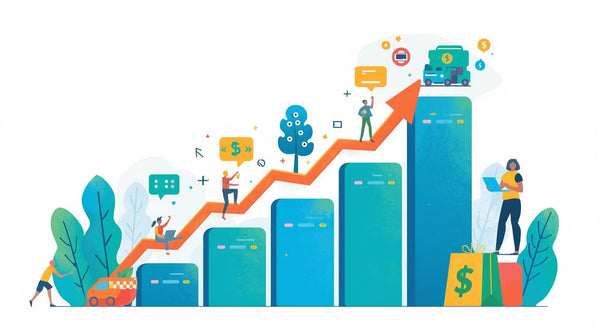Understanding Credit in Shopify Commerce
When you hear the word credit, most people immediately think of credit cards, banks, or personal loans. But in business especially in the Shopify ecosystem credit goes much deeper. It isn’t just about borrowing money; it’s about trust, leverage, and the ability to keep your store running smoothly even when cash isn’t instantly available.
Credit is essentially the fuel that lets businesses operate beyond their immediate cash on hand. It allows Shopify merchants to buy inventory before sales come in, invest in marketing without draining their accounts, or negotiate better terms with suppliers. Without some form of credit, most businesses would struggle to grow past their earliest stages.
For online entrepreneurs, credit can mean:
-
Supplier Credit – Ordering inventory with payment due later.
-
Business Credit Cards – Covering ad spend, apps, or shipping costs.
-
Credit Lines & Loans – Getting working capital to scale operations.
-
Shopify Capital – Shopify’s own lending program designed for store owners.
Why does this matter? Because Shopify stores don’t just live on sales they run on cash flow. And credit, when used strategically, is the bridge that smooths out the gaps between expenses and revenue.
Insight: Many first-time Shopify merchants underestimate the role of credit until they hit their first growth bottleneck. Suddenly, inventory needs to double for the holiday season, or an ad campaign requires upfront spend and without credit, opportunities slip away.
Think of credit as oxygen for your Shopify business. You might not notice it when everything’s calm, but the moment you run short, operations choke. On the other hand, too much careless borrowing can weigh you down, creating debt instead of growth.
At EcomSpiders, we’ve seen both sides. We’ve worked with Shopify brands that leveraged credit wisely to scale to seven figures and we’ve also seen those that drowned in poor financial management. That’s why understanding credit isn’t just a financial skill; it’s a survival skill in ecommerce.

1. What is Credit?
At its core, credit is trust. It’s the ability to receive money, goods, or services today, with the promise that you’ll pay later. Every business, whether it’s a local shop or a Shopify store selling worldwide, relies on this invisible system of trust to keep moving forward.
For a business owner, credit can take many forms:
-
Buying inventory from suppliers on credit – Many wholesalers allow merchants to take stock now and pay after 30, 60, or even 90 days.
-
Using a business credit card for marketing campaigns – Ad spend often comes before sales, and cards help bridge that timing gap.
-
Taking a business loan to expand operations – From new product launches to warehouse space, loans provide upfront capital.
-
Offering credit terms to customers (Buy Now, Pay Later) – A growing ecommerce trend that lets shoppers spread payments while you still get paid.
But here’s the deeper layer: in the Shopify world, credit is more than just financial it’s reputational. Your ability to access favorable terms depends on how much others trust your business. A healthy credit score, clean repayment history, and reliable cash flow all shape the level of support you’ll get from banks, investors, and even suppliers.
Insight: Think of credit as your business reputation translated into numbers. When Shopify merchants manage credit wisely, doors open lower interest rates, higher credit limits, and flexible supplier agreements. But when it’s ignored, those same doors slam shut, making growth much harder.
In short, credit isn’t just about borrowing it’s about proving that your Shopify business is dependable. And in ecommerce, that reputation can be the difference between scraping by and scaling fast.

2. Why Credit Matters for Shopify Businesses
If you’re running a Shopify store, you already know that cash flow is everything. The reality of ecommerce is simple: money rarely comes in at the same pace it goes out. That’s where credit steps in it smooths out the rough patches and keeps your store moving forward.
Let’s break it down with a few real-world scenarios:
-
Buying inventory before the holiday rush – The biggest shopping season requires big upfront investment. Credit allows you to stock up early so you’re ready when demand spikes.
-
Launching ads while waiting for payouts – Shopify Payments often takes a few days to release funds. Instead of pausing campaigns, credit bridges the timing gap so your momentum doesn’t stop.
-
Scaling into new markets – Expanding internationally, upgrading packaging, or hiring staff all require resources before the sales roll in. Credit accelerates that process.
-
Managing supplier terms – Many suppliers give discounts for bulk orders. With credit, you can seize those opportunities without draining your bank account.
Insight: Without credit, growth often stalls because most Shopify stores don’t have piles of cash sitting around. Even profitable businesses can hit a wall when money is tied up in unsold inventory or pending payouts.
In other words, credit isn’t just a safety net it’s a growth engine. It gives Shopify entrepreneurs the breathing room to take risks, invest in marketing, and move faster than competitors who are waiting on cash flow to catch up.
3. How Credit Works in Simple Terms
At its simplest, credit is a cycle of trust. You borrow resources today with the commitment to pay them back tomorrow. If you do that consistently, lenders, suppliers, and even customers begin to trust you more. Over time, that trust translates into bigger opportunities.
Here’s the flow broken down:
-
You borrow money or goods – This could be taking a loan, using a credit card for Facebook ads, or getting inventory on supplier terms.
-
You repay within an agreed time – Whether it’s 30 days for a supplier invoice or the end of the month for a card balance, timely repayment is key.
-
Your credit reputation improves – Each on-time repayment strengthens your track record. Lenders and partners see you as reliable.
-
Access to larger credit – With a stronger reputation, banks or providers extend bigger credit lines, giving you more flexibility to scale.
Think of credit as a ladder. Each payment on time is a step upward. Miss a payment, and you slide down a few rungs. The higher you climb, the more leverage you gain to invest, expand, and weather challenges.
In the Shopify context, this cycle is powerful because ecommerce is often cash-intensive. You might need to order 1,000 units of a product before you ever sell the first one. Good credit allows you to take that leap, while bad credit can leave you stuck in survival mode.
Key Insight: Credit doesn’t just measure your ability to pay it measures your discipline. Businesses that treat credit responsibly unlock cheaper borrowing, better supplier deals, and faster growth.

4. Types of Credit for Businesses
Shopify merchants rarely rely on just one source of credit. Instead, they pull from different options depending on the season, growth stage, and type of expenses. Let’s break down the most common forms of credit you’ll come across:
1. Trade Credit
This is when suppliers give you products upfront and let you pay later usually within 30, 60, or even 90 days.
-
Why it matters: It frees up cash so you can sell inventory before paying for it.
-
Advantage: Improves cash flow and lets you stock up without draining your bank account.
2. Business Credit Cards
A staple for most small businesses, credit cards are flexible and fast. You can use them for marketing campaigns, software subscriptions, or even emergency expenses.
-
Advantage: Rewards, points, and cashback can add extra value.
3. Lines of Credit
Think of this as a financial safety net. Instead of borrowing a lump sum, you get approved for a limit and draw only what you need.
-
Advantage: Interest is charged only on what you use, not the full limit.
4. Term Loans
These are structured loans borrow a fixed amount and pay it back over a set schedule. Many Shopify businesses use them for big investments, like warehouse upgrades or entering a new market.
-
Advantage: Predictable repayments make it easier to budget.
-
Disadvantage: Less flexible; you’re locked into repayment even if your sales slow down.
5. Buy Now, Pay Later (BNPL) for Customers
This isn’t credit for you, but for your buyers. Offering BNPL options at checkout can increase conversions and average order value. Platforms like Shop Pay Installments have made this a game-changer in ecommerce.
-
Advantage: Attracts more customers by lowering upfront payment barriers.
The takeaway: There’s no “one-size-fits-all” approach. Early-stage stores may lean heavily on credit cards and trade credit, while scaling businesses mix in term loans and lines of credit. The smartest Shopify merchants combine multiple credit tools to stay flexible and resilient.

5. Advantages of Credit for Shopify Stores
Credit isn’t just about borrowing it’s about leverage. In the world of ecommerce, timing is everything. Having access to credit can mean the difference between seizing an opportunity and missing out. When used wisely, credit becomes a growth tool, not just a safety net.
1. Improves Cash Flow
Cash flow is the heartbeat of your Shopify business. Expenses like inventory restocking, ads, and shipping don’t always align perfectly with payout schedules from Shopify Payments or PayPal. Credit fills that gap.
-
Example: You may need to buy Christmas inventory in October, but your Shopify payouts trickle in weekly. With credit, you don’t have to wait—you can stock up early and be ready for the rush.
2. Supports Growth
Credit isn’t just for emergencies; it’s fuel for expansion. Whether it’s launching a new product line, running a large ad campaign, or entering international markets, credit gives you the upfront capital to scale faster than profits alone allow.
-
Example: Many stores double their ad budgets during peak sales seasons, knowing that credit lets them front-load spending before the revenue comes back.
3. Builds Reputation
Just like individuals build a personal credit score, businesses build a credit profile. Timely repayments and responsible credit use send a strong signal to banks, lenders, and even suppliers.
-
Advantage: With a strong credit history, you can access bigger credit lines, better interest rates, and more favorable supplier terms.
4. Flexibility During Slow Months
Every Shopify merchant knows sales aren’t always steady. Some months are booming, others are quiet. Credit smooths out the bumps, ensuring you can still pay employees, cover ad costs, or keep inventory moving even when sales dip.
-
Example: If January is slow after the holiday rush, a line of credit can help you survive until spring sales pick up.
5. Competitive Edge
Not every competitor has credit at their disposal. If you can secure inventory faster, run stronger ad campaigns, or test new markets while others wait for profits to roll in, you automatically gain an edge.
The bottom line: Many successful Shopify stores don’t scale solely from profit reinvestment they scale through smart, strategic use of credit. It’s not about being in debt, but about using financial tools to create momentum.

6. Disadvantages of Poor Credit Use
Credit is like fire. In the right hands, it warms the house; in the wrong hands, it burns it down. While credit can accelerate growth, poor management can just as quickly stall or even destroy a Shopify business. Let’s break down the main risks.
1. Debt Burden
Borrowing too much without a clear return plan creates a trap. Instead of fueling growth, the borrowed funds become a weight that drags down profits.
-
Example: A store takes a $50,000 loan to expand into three new markets, but only one market delivers sales. Suddenly, the debt repayment is larger than the extra revenue generated.
2. High Interest Costs
Interest is the silent killer of profit margins. Revolving credit cards, late payments, and penalty fees pile up quickly. What seemed like “cheap money” becomes an expensive liability.
-
Insight: If your ads generate a 20% return but your credit card charges 24% APR, you’re not growing you’re shrinking.
3. Cash Flow Stress
When a business relies too heavily on credit, it becomes fragile. One unexpected dip in sales, one delayed payout, or one sudden supplier issue can cause the repayment cycle to collapse.
-
Example: If your monthly credit card minimums exceed your average Shopify payout, you’re operating on thin ice.
4. Damaged Reputation
Credit isn’t just financial it’s reputational. Missed payments don’t just hurt your business credit score, they weaken supplier trust. A supplier who once gave you 60-day payment terms may demand upfront payments if you miss deadlines.
-
Consequence: Losing supplier trust can choke your supply chain, especially during high-demand seasons.
5. Growth Backfires
Ironically, credit misuse often happens during growth phases. A store scaling too fast adding products, running massive ad campaigns, or expanding internationally without a repayment strategy often collapses under its own weight.
-
Case in Point: We’ve seen Shopify merchants triple sales in six months but fold just as quickly when credit repayments outpaced revenue.
The takeaway: Credit is powerful, but it isn’t free. Every dollar borrowed comes with responsibility. The discipline to repay on time, track ROI, and borrow strategically is what separates thriving Shopify stores from those that collapse under debt.

7. How to Build Good Business Credit
Strong business credit doesn’t happen overnight it’s earned through consistency and discipline. Just like Shopify growth is a journey of small wins, building credit is about making the right moves, repeatedly, until trust is established with banks, suppliers, and lenders. Here’s how Shopify entrepreneurs can lay the foundation.
1. Register Your Business Officially
Operating as a sole proprietor limits your ability to separate personal and business credit. By registering as an LLC or corporation, you give your business its own legal identity.
-
Benefit: Banks, lenders, and even Shopify Capital are more likely to approve financing for a properly registered business.
2. Open Business Bank Accounts
Mixing personal and business money creates confusion and lenders see it as a red flag. A dedicated business checking account makes transactions transparent, builds credibility, and keeps records clean for credit bureaus.
-
Pro Tip: Deposit all Shopify payouts here and pay expenses through this account to create a clear financial trail.
3. Use a Business Credit Card (and Pay on Time)
Business credit cards aren’t just for spending they’re tools for building your credit score. Start with small recurring expenses like Shopify subscriptions, app fees, or ads, then pay the balance in full every month.
-
Example: A store owner who consistently pays off $2,000 in ad spend builds a history of reliability that banks notice.
4. Build Trade Relationships with Suppliers
Many suppliers offer net-30 or net-60 trade credit, allowing you to pay after receiving goods. If those suppliers report to credit agencies, every on-time payment boosts your business credit profile.
-
Insight: Even small relationships like paying your packaging supplier on time help build a stronger credit file.
5. Keep Credit Utilization Low
Maxing out your credit line signals risk to lenders. A good rule is to keep utilization under 30% of your available credit. For example, if your card has a $10,000 limit, avoid carrying a balance above $3,000.
-
Why it matters: Low utilization shows you’re not desperate for funds, which increases lender confidence.
6. Monitor Your Business Credit Reports
Just as you’d check Shopify analytics daily, monitor your business credit score regularly. Errors happen catching and correcting them early prevents surprises when you apply for funding.
-
Resource: Agencies like Dun & Bradstreet, Experian Business, and Equifax Business track your credit profile.
7. Borrow Small, Repay Big
Start small. Take a modest loan or line of credit, repay it early, and repeat. Each successful repayment increases the size and speed of future approvals.
-
Example: Many Shopify owners qualify for larger Shopify Capital advances only after proving repayment on smaller ones.
The takeaway: Building good business credit is less about flashy moves and more about consistency. Register properly, separate your accounts, pay on time, and keep your utilization healthy. Over time, this builds resilience ensuring that when opportunities knock (a new product launch, a big ad push, or a seasonal spike), you have the financial strength to act quickly.

8. Credit and Shopify Growth Strategies
Credit isn’t just about filling short-term cash gaps it’s a growth multiplier when used with intention. Think of it as the bridge between where your business is today and where you want it to be tomorrow. The key is to use borrowed funds not just for survival, but for initiatives that generate a return on investment (ROI). Here’s how smart Shopify merchants use credit to scale faster:
1. Inventory Scaling Before Seasonal Spikes
-
Seasonal surges like Black Friday, Christmas, or Eid sales can make or break a Shopify store.
-
Credit allows you to purchase inventory in bulk before demand hits, often at better supplier rates.
-
Example: A fashion store uses a line of credit to stock trending styles ahead of the holiday rush. By the time sales roll in, the profits easily cover repayment plus interest.
2. Marketing Boost When It Matters Most
-
Ads drive traffic, but waiting for Shopify Payments payouts can delay campaigns.
-
Credit helps you launch marketing campaigns immediately, instead of missing the timing window.
-
Example: A beauty brand invests $5,000 in paid ads before Valentine’s Day. The campaign generates $20,000 in sales, making the short-term borrowing a profitable decision.
3. Technology and Tools Upgrades
-
Shopify success isn’t just about products it’s also about the experience. Credit lets you invest in:
-
Premium themes for higher conversion.
-
Automation apps for order fulfillment.
-
Analytics tools for better decision-making.
-
-
These upgrades improve customer experience and long-term efficiency, even if profits haven’t yet caught up.
4. Geographic Expansion
-
Growing beyond your local market requires upfront spending: shipping setups, translations, localized marketing, or even regional warehouses.
-
Instead of waiting years to build cash reserves, credit allows Shopify stores to test and enter new regions quickly.
-
Example: A Canadian store uses credit to launch targeted ads in the US, testing the market without draining existing cash flow.
5. Product Development and Testing
-
Many Shopify stores expand by launching new product lines.
-
Credit funds prototypes, packaging, and early production runs before sales start rolling in.
-
This way, you can test and scale faster without putting daily operations at risk.
6. Building Partnerships and Collaborations
-
Influencer marketing, wholesale partnerships, or co-branded campaigns often require upfront payment.
-
With credit, you can seize these opportunities quickly, rather than letting cash limitations hold you back.
The bottom line: Credit is not just about “keeping the lights on.” It’s about shortening the timeline between ambition and execution. Used wisely, it gives Shopify entrepreneurs the ability to move at the speed of opportunity instead of the pace of cash flow.

The Future of Credit in Ecommerce
Credit in ecommerce isn’t standing still it’s reshaping itself around digital platforms like Shopify. Traditional credit models were built for brick-and-mortar businesses, but today’s online-first world is driving new tools, faster approvals, and more creative financing options. Here’s where things are headed:
1. Buy Now, Pay Later (BNPL) Becoming Standard
-
At checkout, customers now expect flexible payment choices.
-
BNPL options like Shop Pay Installments, Klarna, and Afterpay let shoppers split purchases into smaller payments without heavy upfront costs.
-
For merchants, this increases conversion rates, average order value (AOV), and customer loyalty.
-
Trend: In the near future, BNPL won’t be a “perk” it will be as normal as offering credit cards.
2. Rise of Fintech Lenders Over Traditional Banks
-
Traditional banks often demand long paperwork and collateral, making it hard for small Shopify stores to qualify.
-
Fintech lenders like Shopify Capital, Clearco, and Payoneer are changing the game. They use real-time sales data instead of credit history to approve loans faster.
-
This means funding is often deposited within days, not weeks.
-
But with convenience comes responsibility merchants need to weigh fees, repayment terms, and risks carefully.
3. Merchant Cash Advances and Revenue-Based Financing
-
Instead of fixed loan repayments, many fintech lenders now offer merchant cash advances (MCAs) where repayment is tied to daily or weekly sales.
-
For Shopify stores with fluctuating income, this flexibility can ease pressure.
-
However, MCAs often come with higher fees than traditional loans—making cost analysis essential.
4. Integrated Credit Solutions Inside Shopify
-
Shopify itself is moving toward becoming not just a platform, but a financial ecosystem.
-
With tools like Shopify Balance (business banking), Shopify Capital (lending), and Shop Pay Installments (BNPL), credit is being built directly into the merchant dashboard.
-
The future may see even AI-driven funding suggestions, where Shopify automatically recommends the right credit option based on your store’s performance.
5. Expansion Beyond Merchants to Customers
-
Credit is no longer just for store owners. Customers are demanding subscription flexibility, microcredit for small purchases, and loyalty-linked credit programs.
-
Expect ecommerce credit to become more personalized, where each shopper gets tailored credit terms based on buying behavior.
6. Globalization of Ecommerce Credit
-
As Shopify merchants increasingly sell across borders, lenders are working on cross-border credit models.
-
A merchant in Pakistan or Canada could access financing based on international sales, not just local banking rules.
-
This levels the playing field for small businesses competing globally.
The takeaway: The future of credit in ecommerce is faster, more flexible, and deeply integrated into platforms like Shopify. But with these opportunities comes greater responsibility Shopify merchants must stay disciplined, compare options, and align credit with growth strategies rather than short-term fixes.

Final Thoughts: Credit as a Shopify Growth Lever
Credit isn’t good or bad. It’s a tool. Managed well, it can propel a Shopify store to new heights. Mismanaged, it can erode profits and trust.
For business owners, the key is understanding the balance between cash, credit, and growth.
At EcomSpiders, we work with Shopify clients not just on design and migration, but also on backend systems like payment management, finance tools, and inventory planning. If you’re considering how to use credit to grow smarter or need to upgrade your Shopify operations reach out to us.
We offer a free consultation to help you understand your store’s financial health and set up systems that support sustainable growth.





0 comments